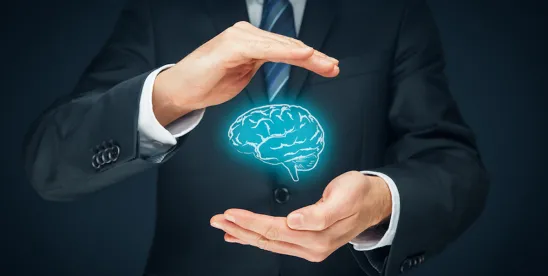When Paul R. Michel was approached about co-authoring a paper on the substantive issues that generative artificial intelligence poses to intellectual property law, the retired chief judge of the U.S. Court of Appeals for the Federal Circuit didn’t think the challenges were all that formidable.
But as Judge Michel and co-author Jim W. Ko began digging into the subject matter, he quickly realized how mistaken he was. And the deeper they dug, the more daunting the project became.
“I was describing it to somebody like you got on a strong-willed horse, and the horse started running away, and there was no way to get off,” Judge Michel said. “If you had asked me on March first if I was going to become obsessed with this, I would have told you no. I didn’t think it was that big a deal. But I became very interested, very obsessed, very quickly.
“Now it’s a huge deal in my view. AI presents the country with a whole set of challenges. It expands into so many aspects of the law: copyright, patents, trade secrets, trademarks, antitrust law, competition law, privacy law. Who’s going to direct the policy responses?”
The resulting paper, Testing the Limits of the IP Legal Regimes: The Unique Challenges of Artificial Intelligence, was published in August and is included in The Sedona Conference Journal Volume 25, Number 1. It focuses on six key issues relating to the intersection of AI and intellectual property law:
- Should Generative AI-assisted works of authorship or inventions be eligible for copyright or patent protections?
- Should GenAI-assisted software code be eligible for copyright protection?
- Should the patentability of inventions be recalibrated given the impact of the proliferation of AI on prior art and the knowledge of a person having ordinary skill in the art?
- Should the use of public GenAI in a company’s product development lifecycle presumptively constitute public disclosure invalidating patent or trade secret rights?
- Should individuals have rights against the use of GenAI to create deepfakes appropriating their identities?
- Are copyrighted works protected from being used in training generative AI models? If not, should they be?
“AI uproots one of the core premises for IP law,” explained Ko, a partner at Chicago-based Wood Phillips. “For patenting inventions and copywriting works of authorship, all IP law has been based on the premise that the inventor or creator is a human being. Now with the advent of Generative AI, we have machines that can replicate at least to some degree some of the inventive or creative processes. This raises all sorts of issues for patent and copyright law in particular.”
Both the U.S. Patent and Trademark Office and the U.S. Copyright Office have published multiple sets of written guidance within the past year regarding Generative AI. Ko and Michel, however, question whether the agencies stepped outside the bounds of procedural rulemaking that is within their authority and into the realm of substantive rulemaking, which at minimum is subject to certain due-process safeguards and may even require an act of Congress to be enforceable.
“What got me going was my reaction to the PTO’s guidance,” Michel said. “What they say in the April guidance really got me alarmed. I thought it was half-baked and harmful in many of its effects.
“As I looked at it, I realized this is a huge deal, it’s going to require enormous changes in the law and action from all three branches of government.”
An initial draft of the paper was presented in June at The Sedona Conference on AI and the Law in Reston, Va., as a means of stimulating a broad conversation on the issues and to serve as a starting point for a new Sedona Conference Working Group on AI and the Law (Working Group 13). Kenneth Withers, executive director of The Sedona Conference, likens the magnitude of these issues to what occurred at the start of the 21st century regarding the required disclosures of electronic documents – leading to publication of the first edition of The Sedona Principles in 2004 to confront the then-novel challenges of eDiscovery that threated to wreak havoc on the litigation system.
“With eDiscovery, courts were trying to fit 20th century paper-based discovery rules into the new world of computer-generated, mass distributed business records and communications,” Withers said. “The requirement to preserve and produce ‘all documents’ relevant to a given subject threatened to sink the judicial system, and we couldn’t even define ‘documents.’
“Similarly, this article questions the feasibility of identifying, documenting, and disclosing all ‘material use’ of AI by patent applicants. It also questions how USPTO patent examiners will determine the level of ‘significant [human] contribution’ now required for patent inventorship by the USPTO,” Withers added.
“One of the first goals of our soon-to-be-formed Working Group on AI and the Law will be to develop Principles and Best Practice recommendations to inventors, companies, the USPTO and USCO, patent lawyers, and judges for fleshing out these disclosure requirements and determining what is reasonable compliance, as AI permeates every aspect of our lives — just like email, cell phones, and text messaging did 20 years ago.”
Among the authors’ many concerns is that smaller inventors or companies can get frozen out of the AI market because of the cost and complexity of working within the patent system. Ko notes a long-term trend, further boosted within the AI-context, for companies to avoid the patent system entirely and rely on trade secret protections instead for their intellectual property.
“There’s a basic economic, corporate, structural problem here,” Michel said. “These AI models are very expensive to design, train, operate and run. A handful of mega corporations have taken the lead, and smaller AI-related firms have struggled because the expense is so great. Giant companies have leapt way ahead of all their rivals. It seems to be like a risk that people should worry about – a handful of companies can end up dominating the whole economy.”
Judge Michel believes Sedona’s consensus-based approach to law and policy, balancing the rights and diverse interests of all stakeholders, is uniquely suited to tackle these complex issues.
“Sedona’s experts really are the experts,” Michel said. “They have the perspective of being in companies, in top law firms, in positions that give them insight that people in government plainly don’t have. None of them have the wisdom, the insight, and all the relevant perspectives, plus the sheer intellectual heft that Sedona’s activists have. Quality decisions, analysis, and policy need a huge amount of private sector input. Government can’t do this well. My hope is that Sedona will be the cutting edge of that.”
But Michel adds a wrinkle. Rather than coming to a consensus on all the issues, which will be constantly evolving, it might be better served by tackling them in bite-sized pieces.
“Sedona’s methodology will have to be applied at Mach speed,” he said. “Otherwise, it will be too late to effect a lot of change. I hope Sedona can find ways to have input into the public and private dialogue. Do it well, do it fast, and if there can be agreement on particular subjects, they should start speaking up.”
Ko and Michel agree that the paper presents more questions than answers.
“It’s very sparse on answers,” Michel said. “It’s not very prescriptive.
“The immediate focus needs to be on identifying all the questions. Technology has surged ahead very fast. The gap between AI and the law keeps growing wider and wider and wider on a daily basis.”
Ko noted that multiple constituencies must be involved in navigating through the issues: “Congressional action will likely ultimately be needed for at least some of the issues identified in our paper. Executive agencies like Patent and Copyright offices have an important role to play. And as with all issues, our judicial system will ultimately have to fill in the gaps in interpreting the law, whether outdated or current.
“Our hope is that members of all branches of our government might benefit from consensus, nonpartisan commentary to come from The Sedona Conference to gain a balanced perspective on these on these AI issues. In many ways, AI represents the culmination of the areas of legal controversy that we have tackled across all Sedona Working Groups in the areas of antitrust law, complex litigation, data security and privacy law, and intellectual property rights over the years.”
Testing the Limits of the IP Legal Regimes: The Unique Challenges of Artificial Intelligence can be downloaded for free from The Sedona Conference website.
Individuals who may be interested in participating in The Sedona Conference’s Working Group process on these AI-related and other issues are encouraged to reach out to comments@sedonaconference.org.




 />i
/>i

